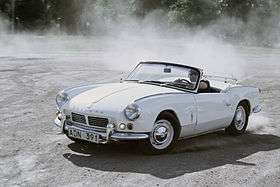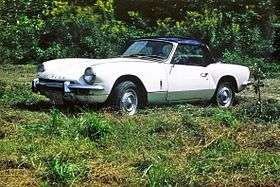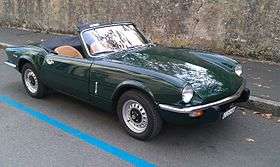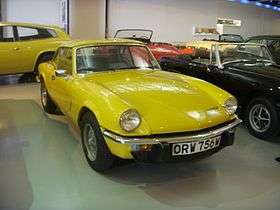Triumph Spitfire
The Triumph Spitfire is a small British two-seat sports car, introduced at the London Motor Show in 1962[3] and manufactured between 1962 and 1980. The vehicle was based on a design produced for Standard-Triumph in 1957 by Italian designer Giovanni Michelotti. The car was largely based upon the chassis of the Triumph Herald saloon, but shortened and without the Herald's outrigger sections. The Herald's running gear and Standard SC engine were also carried over. The Spitfire was manufactured at the Standard-Triumph works at Canley, in Coventry.
| Triumph Spitfire | |
|---|---|
 1974 Triumph Spitfire 1500 (US market) | |
| Overview | |
| Manufacturer | Standard Motor Company[1] Triumph Motor Company (Leyland Motors) |
| Production | 1962–1980 |
| Assembly | |
| Designer | Giovanni Michelotti |
| Body and chassis | |
| Class | Sports car |
| Body style | 2-seat sports convertible / roadster |
| Layout | FR layout |
| Related | Triumph Herald, Triumph Vitesse, Triumph GT6 |
| Dimensions | |
| Wheelbase | 83 in (2,108 mm) |
| Length | 145 in (3,683 mm) |
| Width | 57 in (1,448 mm) |
| Height | 48 in (1,219 mm) hood up. |
| Curb weight | 1,568 lb (711 kg) to 1,750 lb (790 kg) (unladen U.K.spec) |
The bodywork was fitted to a separate structural chassis, but for the open-top convertible Spitfire the backbone chassis' rigidity was augmented by the use of structural components within the bodywork, with the rear trailing arms being bolted to the body rather than the chassis. The Spitfire was provided with a manual soft-top for weather protection, the design improving to a folding hood for later models. Factory-manufactured hard-tops were also available.
Models
Five Spitfire models were sold during the production run:
| Model name | Engine | Year | Number built |
|---|---|---|---|
| Triumph Spitfire 4 (Mark I) | 1147 cc inline-four | Oct 1962 – Dec 1964 | 45,753[1] |
| Triumph Spitfire 4 Mark II | Dec 1964 – Jan 1967 | 37,409[1] | |
| Triumph Spitfire Mark III | 1296 cc inline-four | Jan 1967– Dec 1970 | 65,320[1] |
| Triumph Spitfire Mark IV | Nov 1970 – Dec 1974 | 70,021[1] | |
| Triumph Spitfire 1500 | 1493 cc inline-four | Dec 1974 – Aug 1980 | 95,829[1] |
Origins
The Triumph Spitfire was originally devised by Standard-Triumph to compete in the small sports car market that had opened up with the introduction of the Austin-Healey Sprite. The Sprite had used the basic drive train of the Austin A30/A35 in a light body to make up a budget sports car; Triumph's idea was to use the mechanicals from their small saloon, the Herald, to underpin the new project, this made the vehicle a classic parts bin special. Triumph had one advantage, however; where the Austin A30 range was of unitary construction, the Herald featured a separate chassis. It was Triumph's intention to cut that chassis down and give it a sporty body, saving the costs of developing a completely new chassis-body unit.
Italian designer Michelotti—who had already designed the Herald—was commissioned for the new project, and came up with a traditional, swooping body. Wind-up windows were provided (in contrast to the Sprite and Midget, which still featured side screens, also called curtains, at that time), as well as a single-piece front end which tilted forwards to offer easy access to the engine. In the early 1960s, however, Standard-Triumph was in deep financial trouble, and unable to put the new car into production; it was not until the company was taken over by the Leyland organization that funds became available and the car was launched. Leyland officials, taking stock of their new acquisition, found Michelotti's prototype hiding under a dust sheet in a corner of the factory and rapidly approved it for production.
The Spitfire was named to honour the World War II fighter plane of the same name.[4]
Spitfire 4 or Mark I (1962–64)
| Triumph Spitfire 4 (Mark I) | |
|---|---|
.jpg) | |
| Overview | |
| Production | 1962–1964 45,753 made |
| Powertrain | |
| Engine | 1,147 cc (70.0 cu in) OHV I4 |
| Transmission | 4-speed manual with optional overdrive on top and third from 1963 onwards |
| Dimensions | |
| Curb weight | 1,568 lb (711 kg) (unladen U.K.-spec) |
The production car changed little from the prototype, although the full-width rear bumper was dropped in favour of two part-bumpers curving around each corner, with overriders. The mechanicals were basically from a stock Herald with the notable addition of front disc brakes. The engine was an 1,147 cc (70.0 cu in) four-cylinder with a pushrod OHV cylinder head and two valves per cylinder, mildly tuned for the Spitfire, fed by twin SU carburettors. Also from the Herald came the rack and pinion steering and coil-and-wishbone front suspension, courtesy of the former Alford & Alder company that had been acquired by Standard-Triumph in 1959. At the rear was a single transverse-leaf swing axle arrangement.[5] This ended up being the most controversial part of the car: it was known to "tuck in" and cause violent oversteer if driven too hard, even in the staid Herald. In the sportier Spitfire (and later the six-cylinder Triumph GT6 and Triumph Vitesse) it led to severe criticism.
Known fixes for this include things like camber compensators (essentially a single leaf spring suspended beneath the vertical links), or simply achieving more negative camber to the rear wheels can help the handling become more manageable. The body was bolted to a much-modified Herald chassis, the outer rails and the rear outriggers having been removed; little of the original Herald chassis design was left, and the Spitfire used structural outer sills to stiffen its body tub.
The Spitfire was an inexpensive small sports car and as such had rather basic trim by today's standards, including rubber mats and a large plastic steering wheel. It was nonetheless considered fairly comfortable, as it had roll-down windows and exterior door locks, as well as relatively full instrumentation.[5] These early cars were referred to both as "Triumph Spitfire Mark Is" and "Spitfire 4s",[1] different from the later Spitfire Mark IV. The "Spitfire 4" name indicated the possibility of the appearance of a six-cylinder version.[6]
In UK specification the in-line four produced 63 bhp (47 kW) at 5,750 rpm, and 67 lb⋅ft (91 N⋅m) of torque at 3,500 rpm. This gave a top speed of 92 mph (148 km/h), and a 0 to 60 mph (97 km/h) acceleration in 16.4 seconds. Average fuel consumption was 31 mpg.[1]
For 1964 an overdrive option was added to the four-speed manual gearbox.[3] Wire wheels and a hard top were also available.[3]
An all-monocoque construction derivative of the Spitfire with pop-up headlamps, named the Triumph Fury, was proposed with a single prototype being built.
Spitfire Mark II (1965–67)
| Triumph Spitfire Mark II | |
|---|---|
 | |
| Overview | |
| Production | 1965–1967 37,409 made |
| Powertrain | |
| Engine | 1,147 cc (70.0 cu in) I4 |
| Transmission | 4-speed manual with optional overdrive on top and third |
| Dimensions | |
| Curb weight | 1,568 lb (711 kg)(unladen U.K.spec) |
In March 1965 the Spitfire Mark II was launched. It was very similar to the Mark I but featured a more highly tuned engine with a revised camshaft profile, a water-heated intake manifold, and a tubular exhaust manifold, increasing power to 67 bhp (50 kW) at 6,000 rpm.[1] The coil-spring design clutch of the Mark I was replaced with a Borg & Beck diaphragm spring clutch; North American models retained the coil-spring housing and were also equipped with ACDelco distributors. The exterior trim was modified with a new grille and badges. The interior trim was improved with redesigned seats and by covering most of the exposed surfaces with rubber cloth. The original moulded rubber floor coverings were replaced with moulded carpets.[1]
It was introduced at a base price of £550, compared to the Sprite's £505 and the Midget's £515.[1] Top speed was claimed to be 96 mph (154 km/h) and its 0–60 mph time of 14.8 seconds was considered "lively".[1] The factory claimed that at highway speeds (70 mph (110 km/h)) the car achieved 38.1 miles per imperial gallon (7.41 L/100 km; 31.7 mpg‑US).[1]
Spitfire Mark III (1967–70)
| Triumph Spitfire Mark III | |
|---|---|
 | |
| Overview | |
| Production | 1967–1970 65,320 made |
| Powertrain | |
| Engine | 1,296 cc (79.1 cu in) I4 |
| Transmission | 4-speed manual with optional overdrive on top and third |
| Dimensions | |
| Curb weight | 1,568 lb (711 kg)(unladen U.K.spec) |
The Mark III, introduced in March 1967, was the first major facelift to the Spitfire. The front bumper was raised in response to new crash regulations, as well as the front coil springs being slightly raised, which made the car sometimes look a little out of proportion. Although much of the bonnet pressing was carried over, the front end looked quite different. The rear lost the overriders from the bumper but gained reversing lights as standard (initially as two separate lights on either side of the number plate, latterly as a single light in a new unit above the number plate); the interior was improved again with a wood-veneer instrument surround and a smaller, 15-inch, wire spoked steering wheel. A folding hood replaced the earlier "build it yourself" arrangement. For most of the Mark III range, the instrument cluster was still centre-mounted (as in the Mark I and Mark II) so as to reduce parts bin counts (and thereby production costs) for right-hand and left-hand drive versions.
The 1,147 cc engine was replaced with a bored-out 1,296 cc unit (the bore increasing from 69.3 mm (2.73 in) to 73.7 mm (2.90 in), stroke retained at 76 mm (3.0 in)), as fitted on the new Triumph Herald 13/60 and Triumph 1300 saloons. A new quieter exhaust gave a sweet distinct note and reduced cabin noise. In SU twin-carburettor form, the engine put out a claimed 75 bhp (56 kW) at 6,000 rpm, and 75 lb⋅ft (102 N⋅m) of torque at 4,000 rpm, and made the Mark III a comparatively quick car by the standards of the day. Popular options continued to include wire wheels, a hard top and a Laycock de Normanville overdrive, and far more relaxed and economical cruising at high speeds. The Mark III was the fastest Spitfire yet, achieving 60 mph (97 km/h) in 13.4 seconds,[1] and reaching a top speed of 95 mph (153 km/h). Average fuel consumption was improved slightly at 33mpg.[1] The Mark III actually continued production into 1971, well after the Mark IV was introduced.[1]
On 8 February 1968, Standard-Triumph general manager George Turnbull personally drove the 100,000th Triumph Spitfire off the end of the Canley production line.[7] More than 75 per cent of the total production had been exported outside the UK, including 45 per cent to the US and 25 per cent to mainland European markets.[7]
The 1968 model saw the effects of burgeoning U.S. safety and emissions legislation. For example, from a safety perspective, dual system (aka tandem) brakes were introduced along with a brake failure warning device. The engine's state of tune was attenuated with a milder camshaft and a distributor with idle speed ignition timing retarded to address emissions. The twin SU carburettors now included overrun valves in the throttle discs and anti-tampering features on carburettor fuel-air mixture nuts.[8]
Starting in 1969 US-bound models had to comply with stricter safety and emissions regulations; models produced after 1969 are sometimes referred to as "federal" Spitfires. A reduced compression ratio of 8.5:1 resulted in a slight decrease in power (68 bhp) and 73 ft-lbs of torque. However, the 0–60 time of 14 seconds was still faster than the Mark II. The instrument panel was moved in front of the driver, and new seats were introduced with integrated headrests to help against whiplash. Cosmetically, the wood dash was replaced with a matte black finished assembly intended to imitate an aircraft cockpit.
The Mk. III's final production year (1970) saw a set of exterior changes that included: Addition of an integrated reverse/plate illumination lamp assembly on the rear, addition of full side lamps at the front and rear and new badging.[9] The separate "Triumph" letters on the front of the bonnet were removed and "Triumph" and "Spitfire" rectangular badges were used in the front, rear sides and rear. A limited number of U.S. market 1970s were adorned with an RAF style "Spitfire" badge (U.K. models had a plain badge without the RAF roundel) that rested in the right corner (car opposing point of view) of the bonnet. Additional exterior changes introduced included a zip up rear window, black radiator grille and a black (vs body colored) windshield surround. Full wheel covers of two styles were used including the 1969 introduced model with "SPITFIRE" circumscribing the hub and a unique derivative without the branding. Interior changes included a steering column mounted ignition switch, a key-in-ignition warning buzzer, driver's side under-dash courtesy lamp and a new black spoked steering wheel. Under the bonnet, some markets had the twin SU carburettors replaced with a single Zenith-Stromberg carburettor.[9]
Spitfire Mark IV (1970–74)
| Triumph Spitfire Mark IV | |
|---|---|
 Triumph Spitfire Mark IV | |
| Overview | |
| Production | 1970–1974 70,021 made |
| Powertrain | |
| Engine | 1,296 cc (79.1 cu in) I4 |
| Transmission | 4-speed manual with optional overdrive on top and third |
| Dimensions | |
| Curb weight | 1,717 lb (779 kg)(unladen UK spec) |
The Mark IV brought the most comprehensive changes to the Spitfire. It featured a completely redesigned cut-off rear end, giving a strong family resemblance to the Triumph Stag and Triumph 2000 models, both of which were also Michelotti-designed. The front end was also cleaned up, with a new bonnet pressing eliminating the weld lines on top of the wings from the older models, and the doors were given recessed handles and squared-off glass in the top rear corner. The interior was much improved: a proper full-width dashboard was provided, putting the instruments ahead of the driver rather than over the centre console. This was initially black plastic however was replaced with wood in 1973.
The 75 horsepower engine was now rated at 63 horsepower (for UK market employing the 9:1 compression ratio and twin SU HS2 carburetors; the less powerful North American version still used a single Zenith Stromberg carburetor and an 8.5:1 compression ratio) due to the German DIN system; the actual output was the same for the early Mark IV. However, it was slightly slower than the previous Mark III due to carrying more weight, and employing a taller 3.89:1 final drive as opposed to the earlier 4.11:1.
The Mk. IV engine displaced 1,296 cc (79.1 cu in) throughout the production run, but in 1973 received larger big-end bearings to rationalize production with the TR6 2.5-litre engines, which somewhat decreased its high revving nature. The engine was also slightly detuned to meet new emissions laws. With the overall weight also increasing to 1,717 lb (779 kg) performance dropped as a consequence, with 0 to 60 mph (0 to 97 km/h) now being achieved in 15.8 seconds and top speed reduced to 90 mph (140 km/h).[1] Overall fuel economy also dipped to 32 mpg‑imp (8.8 L/100 km; 26.6 mpg‑US).[1] The gearbox gained synchromesh on its bottom gear.
A new hardtop was also available, with rear quarter-lights and a flatter rear screen.
In another major change, the rear suspension was decambered and redesigned to incorporate what Triumph called a "swing spring". With this system one leaf was eliminated from the stack and only the bottom leaf was attached rigidly to the differential. The remaining leafs were mounted to pivot freely. With this change Triumph eliminated the worst characteristics of the original swing-axle design. This was a different approach than that taken with the Triumph GT6 Mk II (GT6+) and Triumph Vitesse Mark 2, both of which received new lower wishbones and Rotoflex half-shaft couplings. The result on all these cars was improved handling.
The Mark IV went on sale in the UK at the end of 1970 with a base price of £735.[1]
Spitfire 1500 (1974–80)
| Triumph Spitfire 1500 | |
|---|---|
 | |
| Overview | |
| Production | 1974–1980 95,829 made |
| Powertrain | |
| Engine | 1,493 cc (91.1 cu in) I4 |
| Transmission | 4-speed manual with optional overdrive on top and third |
| Dimensions | |
| Curb weight | 1,750 lb (790 kg)(unladen U.K.-spec) |
In 1973 in the United States and Canada, and 1975 in the rest of the world, the 1500 engine was used to make the Spitfire 1500. Although in this final incarnation the engine was rather rough and more prone to failure than the earlier units, torque was greatly increased by increasing the cylinder stroke to 87.5 mm (3.44 in), which made it much more drivable in traffic.[1]
While the rest of the world saw 1500s with the compression ratio reduced to 8.0:1, the American market model was fitted with a single Zenith-Stromberg carburettor and a compression ratio reduced to 7.5:1 to allow it to run on lower octane unleaded fuel,[1] and after adding a catalytic converter and exhaust gas recirculating system, the engine only delivered 53 bhp (40 kW) (DIN) with a slower 0–60 mph time of 16.3 seconds.[10] The notable exception to this was the 1976 model year, where the compression ratio was raised to 9.1:1. This improvement was short-lived, however, as the ratio was again reduced to 7.5:1 for the remaining years of production.
In the UK the 9:1 compression ratio, less restrictive emissions control equipment, and the Type HS2 SU carburettors now being replaced with larger Type HS4 models,[1] led to the most powerful variant to date. The 1500 Spitfire now produced 71 hp (DIN) at 5,500 rpm, and produced 82 lb⋅ft (111 N⋅m) of torque at 3,000 rpm.[1] Top speed was now at the 100 mph (160 km/h) mark, and 0 to 60 mph (97 km/h) was reached in 13.2 seconds.[1] Fuel economy was reduced to 29mpg.[1]
Further improvements to the suspension followed with the 1500 included longer swing axles and a lowered spring mounting point for more negative camber and a wider rear track. The wider, lower stance gave an impressive skid pad result of 0.87g average. This put the Spitfire far ahead of its competition in handling.

The American market Spitfire 1500 is easily identified by the big plastic over-riders and wing mounted reflectors on the front and back wings. The US specification models up to 1978 still had chrome bumpers, but on the 1979 and 1980 models these were replaced by black rubber bumpers with built-in over-riders. Chassis extensions were also fitted under the boot to support the bumpers.
Detail improvements continued to be made throughout the life of the Mark IV, and included reclining seats with "chequered brushed nylon centre panels" and head restraints, introduced for domestic market cars early in 1977 along with a new set of column stalk operated minor controls (as fitted already in the TR7) replacing the old dashboard mounted knobs and switches.[11] Also added for the model's final years were a wood dash, hazard flashers and an electric screen washer, in place of the previous manual pump operated ones.[11] Options such as the hard top, tonneau cover, map light and overdrive continued to be popular, but wire wheels ceased to be available.
The 1980 model was the last and the heaviest of the entire run, weighing 1,875 lb (850.5 kg).[1] Base prices for the 1980 model year were $5,995 in the US and £3,631 in the UK.[1] The last Spitfire, an Inca yellow UK-market model with hardtop and overdrive, rolled off the assembly line at Canley in August 1980, shortly before the factory closed. It was never sold and is now displayed at the British Motor Heritage museum at Gaydon.
Die-cast models
- Dinky Toys produced a model of the Spitfire 4 in the 1960s
- Lledo Vanguards produced models of both the Spitfire 4 and the Mark 3 in the 2000s
- Vitesse produced a model of the Mark IV in the 2000s
- Sun Star produced a 1:18 scale die-cast model of a 1970 MkIV Spitfire in the 2000s
- Minichamps produced a 1:43 Spitfire 1500 in both Green and Mimosa Yellow
- A 1:18 scale die-cast model of a MkIV Spitfire has also been produced under the label Chrono.
References
Notes
- Robson (1982), p. 187.
- SPITTY TIPS – 19. Australian Spitfire Colours Retrieved on 30 March 2012
- "Used car test: 1970 Triumph Spitfire Mk.3". Autocar. 138 (nbr 4022): 26–27. 28 June 1973.
- Triumph advertisement circa 1974: http://www.triumphspitfire.nl/salesliterature/IMG_0051.jpg
- Blunsden, John (October 1962). "Triumph Spitfire 4". Illustrerad Motor Sport (in Swedish). No. 10. Lerum, Sweden. p. 16.
- Blunsden, p. 17
- "News and views: 100,000 Triumph Spitfires". Autocar. 128 (nbr 3757): 58. 15 February 1968.
- Standard-Triumph Sales Ltd (1970). Standard-Triumph Spitfire Mk3 Spare Parts Catalogue. Standard-Triumph Sale Ltd, Spares Division, Coventry, England.
- John., Thomason (2006). Triumph Spitfire and GT6 : a guide to originality. Ramsbury: Crowood. ISBN 9781861268617. OCLC 67375471.
- "Triumph Spitfire: Still attractive after all these years". Sports & GT Cars. 1980.
- "Motorweek:New Models ... Spitfire". Motor: 2. 5 March 1977.
Bibliography
- Robson, Graham (1982). Triumph Spitfire and GT6. Osprey Publishing. ISBN 0-85045-452-2.CS1 maint: ref=harv (link)
Further reading
- Peter G. Strasman and J.H. Haynes. (1987). Triumph Spitfire owner's workshop manual. Haynes. ISBN 1-85010-022-5.
- Porter, Lindsay; Williams, Peter (1988). Triumph Spitfire, GT6, Herald Vitesse: Guide to Purchase and D.I.Y. Restoration. G T Foulis. ISBN 0-85429-583-6.
- British Leyland (1992). Competition Preparation Manual (reprint ed.). Brooklands Books. ISBN 1-870642-60-0.